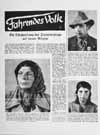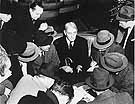
|
|
|

|

|

|

|
|
Click on an image to see a larger, more detailed picture.
|
|
|
|
|
| 1939: The War Against The Jews |

|
pg. 157 |

|
|
|
|
| |
 Among the groups persecuted on racial grounds in the Third Reich were the Sinti and Roma, or Gypsies. The Nazis considered the "criminal" lifestyle of the Gypsies to be genetically determined, like that, they felt, of the Jews. On September 21, 1939, Nazi authorities decided to deport Germany's Gypsies to Poland, where they were interned in special camps. Above is the title page of an article entitled, "Vagabonds: New Ways of Combating the Gypsies."
Among the groups persecuted on racial grounds in the Third Reich were the Sinti and Roma, or Gypsies. The Nazis considered the "criminal" lifestyle of the Gypsies to be genetically determined, like that, they felt, of the Jews. On September 21, 1939, Nazi authorities decided to deport Germany's Gypsies to Poland, where they were interned in special camps. Above is the title page of an article entitled, "Vagabonds: New Ways of Combating the Gypsies."
Photo: United States Holocaust Memorial Museum Photo Archive
|
 George Rublee, a confidant of U.S. President Franklin Roosevelt, led the Intergovernmental Committee on Political Refugees, a panel created by the British and American governments in 1938. They hoped that Rublee could negotiate with the German government to gain more favorable economic conditions for German refugees. Rublee, for example, wanted the German government to permit emigrants to take more of their property with them. His efforts ultimately failed, and he quit his post. This photograph shows Rublee as he arrived in the U.S. on the Queen Mary on February 23, 1939, shortly after his resignation.
George Rublee, a confidant of U.S. President Franklin Roosevelt, led the Intergovernmental Committee on Political Refugees, a panel created by the British and American governments in 1938. They hoped that Rublee could negotiate with the German government to gain more favorable economic conditions for German refugees. Rublee, for example, wanted the German government to permit emigrants to take more of their property with them. His efforts ultimately failed, and he quit his post. This photograph shows Rublee as he arrived in the U.S. on the Queen Mary on February 23, 1939, shortly after his resignation.
Photo: United States Holocaust Memorial Museum Photo Archive
|
 Signifying ferocity and fearlessness, the gruesome skull and crossbones insignia was initially worn by men of the Totenkopfverbände (Death's Head Units). Wearing black uniforms and chosen for their toughness and discipline, these men comprised a special branch of the SS with responsibility for guarding the concentration camps. With the onset of war in 1939, these units became the core of the Waffen-SS.
Signifying ferocity and fearlessness, the gruesome skull and crossbones insignia was initially worn by men of the Totenkopfverbände (Death's Head Units). Wearing black uniforms and chosen for their toughness and discipline, these men comprised a special branch of the SS with responsibility for guarding the concentration camps. With the onset of war in 1939, these units became the core of the Waffen-SS.
Photo: Philip Drell
|
|

|

|

|

|
 February 21, 1939: German Jews are required to surrender all gold and silver to government authorities.
February 21, 1939: German Jews are required to surrender all gold and silver to government authorities.
|
 February-June 1939: New York Democratic Senator Robert F. Wagner, a German American, and Massachusetts Democratic Representative Edith Nourse Rogers jointly propose the Wagner-Rogers Bill to permit 20,000 German children (specifically, Jewish children) into the United States over a two-year period. The bill is tagged with so many amendments that, after hearings, it never leaves the the House or Senate. The bill does receive considerable support from the press and certain churches, and many individuals and organizations testify for or against the bill. But the antisemitism rife in the American public and Congress--and the lack of support from President Franklin Roosevelt--sink the bill. The Wagner-Rogers Bill's foremost opponent, Senator Robert Reynolds of North Carolina, has a secret relationship with German-American Nazi agent August Gausebeck. Gausebeck's partner is Walter Schellenberg, the coordinator of Gestapo activities in the United States.
February-June 1939: New York Democratic Senator Robert F. Wagner, a German American, and Massachusetts Democratic Representative Edith Nourse Rogers jointly propose the Wagner-Rogers Bill to permit 20,000 German children (specifically, Jewish children) into the United States over a two-year period. The bill is tagged with so many amendments that, after hearings, it never leaves the the House or Senate. The bill does receive considerable support from the press and certain churches, and many individuals and organizations testify for or against the bill. But the antisemitism rife in the American public and Congress--and the lack of support from President Franklin Roosevelt--sink the bill. The Wagner-Rogers Bill's foremost opponent, Senator Robert Reynolds of North Carolina, has a secret relationship with German-American Nazi agent August Gausebeck. Gausebeck's partner is Walter Schellenberg, the coordinator of Gestapo activities in the United States.
|
|
|
|
|
| 1939: The War Against The Jews |

|
pg. 157 |

|
|
The Holocaust Chronicle
© 2009 Publications International, Ltd.
|
|
